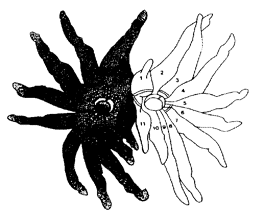 |
Science Frontiers ONLINE No. 88: Jul-Aug 1993 |
|
|
The star of the star-nosed mole
 (Left) Tenticle-like rays surrounding one nostril of the star-like mole. (Right) The number of rays around the other nostril give the density of sensory receptors. |
Actually, scientists have been puzzled as to how this mole found its prey, for this mammal is semiaquatic and somehow locates its dinner in muddy water even though it has poor eyesight. Although some fish possess electrical sensors, they are uncommon in mammals.
Half way around the planet, another strange creature, also classified with the mammals, frequents muddy waters looking for the same sort of prey favored by the star-nosed mole. The Australian platypus also has weak vision and employs search techniques similar to those of the mole. Instead of sensor-bearing tentacles on its prow, the platypus has a duck-like bill loaded with electrical sensors.
(Gould, Edwin, et al; "Function of the Star in the Star-Nosed Mole, Condylura Crista," Journal of Mammalogy, 74:108, 1993.)
Comment. Curious, isn't it. that such distantly related animals evolve similar organs and hunting strategies when confronted with like environments? This is called "parallel evolution;" but naming the process does not tell us how nature accomplishes it. Chance mutations and natural selection? Theoretically possible, but not always convincing. Nature must still be withholding some secret from us!
Reference. Electrosensitivity in mammals is rare, but we have cataloged several instances in BMO8 in our catalog: Bio logical Anomalies: Mammals II. For more information, visit here.